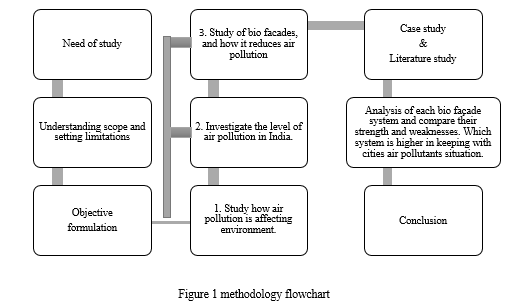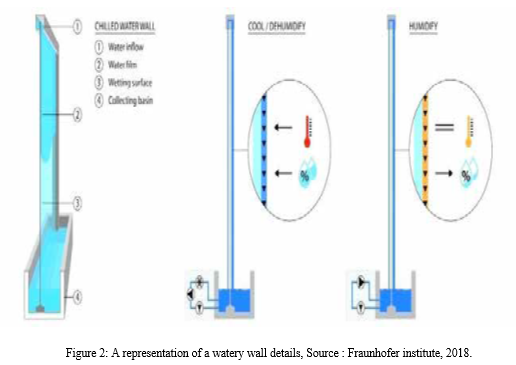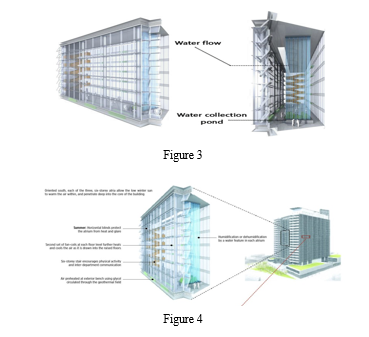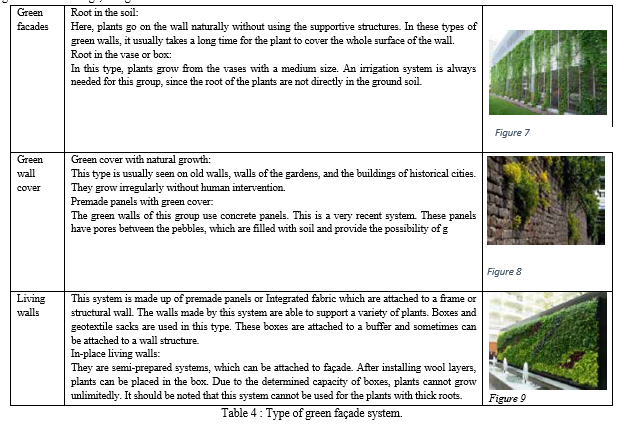Ijraset Journal For Research in Applied Science and Engineering Technology
- Home / Ijraset
- On This Page
- Abstract
- Introduction
- Conclusion
- References
- Copyright
Mitigating Air Pollution in Indian Cities with the Use of Bio Facades
Authors: Ar. Rashmi Singh, Ar. Shailesh Kumar Yadav
DOI Link: https://doi.org/10.22214/ijraset.2023.54333
Certificate: View Certificate
Abstract
Today, the biggest issues facing the planet are air pollution and, as a result, global warming. These problems may affect the climate, human health. To mitigate air pollution frequently concentrate on reducing the sources of the pollutants. This approach can significantly lower the amount of new air pollutants, but it has little impact on the air\\\'s already-existing contaminants. By recognizing the current situation, this study seeks to limit the level of harm to humans by regulating air pollution through municipal engineering, facade structures, and architectural design. The air quality of the urban environment can be significantly influenced by the façades of buildings. The ability of nature to manage air pollution has been used to the realm of architecture. Therefore, this study compares three different forms of bio-façades (namely, Water façade, Green façade, and Microalgae) by utilizing nature\\\'s capacity to manage carbon dioxide. These facades do not harm human health and do not require any special technology. . Then, after identifying the aforementioned biological façade kinds, we compared their strength and weaknesses, cost, environmental stability and chose the best one. Which façade system is best according to Delhi and luck now’s air pollution condition. Purpose: The goal of this study is to gain a better understanding of how can we improve air quality and reduce pollutants with the help of bio facade.
Introduction
I. INTRODUCTION
One of the five things that humans need to survive is air. Each human needs around 15 kilograms of air per day and breaths approximately 22,000 times per day. Humans can typically go without food and drink for 5 weeks and 5 days, but they cannot go without air for even 5 minutes. According to a statistic from the World Health Organization, air pollution claims 2.4 million lives each year. Cities are growing too quickly, which is causing environmental damage and issues like air pollution. The biggest issues facing the planet right now are air pollution and, as a result, global warming.
Air pollution directly impacts air quality. As a result, one of the key challenges for countries and governments is dealing with air pollution. This issue is being addressed by numerous institutions and organisations in an effort to find a solution. The final half of the 20th century saw a high in the discussion of environmental issues, even though mankind has long appreciated the value of the environment in their daily life. Environmental issues today provide a serious threat to humanity, endangering not just their comfort and safety but also their very life. The problem of environmental pollution affects the entire world and is not limited to any one nation or region. It is made up of several separate problems, the most significant of which are air and water pollution.
Based on the last report from the World Health Organization, air pollution is one of the main cause of human death. According to 2019 report of India death rate is 1.6 million. A majority of these deaths were caused by particulate matter 2.5 (PM 2.5) pollution, it added. This study looks for solutions to this issue in urban architecture and design. By lowering energy use and air pollution, sustainable architecture aims to improve quality of life.
Paying attention to nature as a model and solution for modifying environmental problems is one of the most crucial methods in architecture and urban engineering. In this study, bio-based facades are presented as a technique to manage and reduce air pollution.
II. RESEARCH BACKGROUND
Currently, during the period from September to April, people around the world can see with their own eyes and feel with their own breath the pollution of the air called smog. The main cause of smog and the source of air pollution are exhaust gases from large factories, burning coal in furnaces, and car exhausts.
Air pollution, known as smog, has increased in recent years. It usually occurs in large cities, where exhaust emissions and energy consumption are very high. Road traffic has a significant impact on the formation of photochemical smog. Often people prefer their own cars to public transport due to convenience or lack of other options. This leads to a high volume of traffic on the roads. This increases the emission of exhaust gases from tailpipes and the escape of dust from worn tires and asphalt into the atmosphere. Passing cars also stir up pollutants lying on the roads. The problem is the condition of the cars. They often do not meet standards. Rapidly developing countries have a big problem with air pollution and thus with the environment as such. This also has a negative impact on human health.
Each component of smog has a negative impact on human health, but just as the composition of smog can vary and is constantly changing, so are its effects. The constituents it contains are very dangerous to humans.
According to the World Air Quality Report published on Tuesday (March 22) by IQ Air, a Swiss company, India's air pollution levels increased in 2021, breaking a three-year trend of improved air quality. India ranks sixth out of 117 countries, regions, and territories in the world for pollution. In 2021, the nation's yearly average PM2.5 concentrations rose to 58.1 g/m3, which was pre-quarantine levels as reported in 2019. After revising its recommendations in 2021, the WHO now advises that average yearly readings of the microscopic, dangerous airborne particles known as PM2.5 should not exceed 5 micrograms per cubic metre.
Delhi: For the fourth year in a row, Delhi, the nation's capital, topped the list of the world's most polluted capital cities. In 2021, Delhi's PM2.5 concentrations increased by 14.6%, going from 84 g/m3 in 2020 to 96.4 g/m3.
Lucknow: The city's air quality has once again deteriorated significantly, surpassing even the extreme pollution levels seen in the pre-Covid eras. Pre-monsoon season harmful PM 2.5 concentrations are 43.9% higher than they were a year ago. In addition, there were 10% greater PM 2.5 concentrations than in 2019.
A. Research Question
Research is based on general questions
- Do nature and architecture have a role in controlling air pollution discussion?
- What types of bio-facades can reduce the air pollution?
- Which facades are productive for delhi and lucknow among air pollution preventive bio-facades?
According to research questions, the main hypothesis of this research is expressible in two sentences:
- Bio-based facades are effective in achieving urban comfort by reducing air pollution.
- Green walls are a proper alternative for reducing Lucknow’s air pollution.
Reasons that can be named for testing the accuracy before entering research are:
- Nature has always been the right answer to human and environments’ needs.
- Green areas have a significant role in controlling air pollution.

III. RESEARCH METHODOLOGY
This study is based on reading accessible references of buildings studies that currently exist since its goal is to show solutions for decreasing the effects of air pollution via bio-based facades. However, this research must be expanded by conducting multidisciplinary research in combination. After introducing the systems and highlighting their strength limitations in tables, quantitative data regarding each system's performance was collected. The research was then conducted using a practical approach by contrasting the qualitative and quantitative data for each system.
IV. DISCUSSION
A. Architectural bio-based facades for controlling air pollution
Architecture may successfully improve air quality and have a favourable or negative impact on a building's energy productivity. This is demonstrated by several studies with various names that have been conducted in various nations. But the study's focus on bio-facades is not the only type of façade that can reduce air pollution; other constructions made of technologically advanced materials also fall under this category. Overall, the study's primary emphasis is on facades inspired by nature.
Bio façades are:
- Water Façade
- Algae façade
- Green Facades
- Water Façade
Using Water in the Outer Shell of the Building. The idea of using water to absorb air pollutants comes from the purification of the air by rain. During rain, water droplets purify the air by absorbing air pollutants and fine dust, and by dissolving them in themselves. Apart from the practicality of water walls or curtains, they can contribute to the removal of pollutants and air conditioning. Though this purification system gained popularity for its aesthetics aspect.

a. Strength and Weakness of Water Façade
|
|
Strength |
Weaknesses |
|
Climate aspects |
|
|
|
Financial aspects |
|
|
|
Architecture and structure aspects |
|
|
|
Environmental aspects |
|
|
|
Stability aspects |
|
|
Table 1: comparison of water façade system, source author
b. Manitoba Hydro Place, Canada
Officially opened: September 29, 2009;
Building size: 64,590 square metres; Number of storeys: total of 22;
Building height:
- 115 meters to top of solar chimney;
- 88.6 meters to top of building;
- 98.6 meters to top of mechanical penthouse.
Occupant capacity: 2,245;
Green roofs: 3rd floor, east and west sides;
Underground parking: 152 spaces;
Building cost: $283 million.
Energy reduction: 70% less energy than a comparable office building of conventional design.
The Manitoba Hydro Place was designed by KPMB Architects, it is the headquarters of the Manitoba hydro energy utility company.
2. Algae Façade
The most basic kind of plants are microalgae (without roots, stems, leaves, and other plant organs). The majority of these types of live microorganisms are single-celled. They have a far higher capacity for absorbing and decreasing carbon dioxide than organic plant species because they have a higher surface-to-volume ratio. Through the process of photosynthesis, which involves taking in carbon dioxide from the atmosphere or water, microalgae produce 60 to 75 percent of the oxygen required by people and other creatures (more than all forests and greenies on Earth). Microalgae create a type of green biomass and nourishing protein during the process of absorbing carbon dioxide and producing oxygen. Additionally, microalgae photosynthesize ten times more than adult trees and grass. They need to take in 1.8 kg of carbon dioxide in order to produce 1 kilogramme of microalgae biomass.
These organisms may flourish in any aquatic environment, including saltwater, sewage water, and tap water, and do not require clean water to do so. Because microalgae obtain the majority of their nutrients from sewage, sewage is the ideal environment in which to grow them. Building façades can be made into biological façades by integrating microalgae, which can transform the walls into surfaces that can produce oxygen. Building walls are made up of vast surfaces that are exposed to polluted air. In this manner, they can improve the structure's passive thermal performance in response to climatic change and turn an ordinary structure into a healthy and energetic structure. It can also transform the structure's walls into a power station. A water storage tank and culture are required to integrate microalgae with the building's façade. Algae are a limitless supply of food, energy, and most importantly, a natural CO2 absorber.

a. Key Benefits
- 5.5 kg yield of biomass (per sqm bioenergy façade per year).
- 38% energy conversion into heat.
- 8% energy conversion into biomass.
- 10kg co2 absorption (per sqm bioenergy façade per year).
b. Strength and Weakness of Algae Façade
|
|
Strength |
weakness |
|
Climate aspects |
Creating sub-climates |
Lack of suitable functioning in all climates |
|
Financial aspects |
Increasing value in the market |
of technology in the country)
|
|
Architecture and structure aspects |
|
|
|
Environmental aspects |
|
|
|
Stability aspects |
|
|
Table 2 comparison of algae façade system, source author
c. BIQ (Bio Intelligent Quotient) House, Hamburg, Germany
The BIQ (Bio Intelligent Quotient) house represents the world’s first pilot project for the implementation of a bio-reactive façade in residential buildings. The bio-reactive façade, called Solar Leaf, generates renewable energy from algae biomass and solar thermal heat. In particular, the BIQ house in Hamburg has 200 m2 of algae filled bio-reactive paneling, which supplies the building with all of the energy it needs while reducing carbon dioxide (CO2) emissions by 6 tons per year.
|
Photo bioreactor panel energy indicators |
Value |
|
Bio methane production |
612m? |
|
Net energy as methane |
Approx. 4541 kWh/year |
|
Net energy from heat |
Approx. 6,000 kWh/year |
|
Carbon dioxide emission reduction |
6 tons/year |
|
Basic data per sqm bioreactor area biomass production |
900 kg/year |
|
Energy production from biomass |
345ki/m²/day |
|
Biogas production from biomass |
10.20L methane/m² |
|
|
|
|
Table 3
3. Green Façade
The utilisation of plants, both on a small-scale and a large-scale, can significantly reduce air pollution. Because they can be added to existing or under construction buildings and fit in the restricted space, green façades are one of the most well-liked and frequently used methods of absorbing air pollution in cities. Green facades are a useful technology to eliminate pollution from the environment. These walls have the capacity to filter harmful gases, airborne suspended particles, and other impurities. The surfaces of leaves filter harmful gases and absorb pollen and dust. Plants and microbes both function as filters. The concept behind living architecture improves the air quality and regulates the intensity of rain by using plant growth on building surfaces. Vertical green facades are preferable to the more general phrase "green facades." Vertical green systems can be divided into three main groups: live walls, green wall coverings, and green facades.

|
Tree as dust collectors |
|
|
Trees species |
Dust collected gm/sq m of leaf surface |
|
Tectona grandis (Teak) |
5.35 |
|
Shorea robusta (Sal) |
4.50 |
|
Terminalia arjuna (Behera) |
4.49 |
|
Mangifera indica (Mango) |
4.05 |
|
Bauhinia purpuria (Kachnar) |
3.90 |
|
Butea monosperma (Plaw) |
3.05 |
|
Azadirachta indica (Neem) |
2.29 |
|
Cassia fistula (Amal tas) |
2.24 |
|
Tamarindus indica (Imli) |
2.08 |
Table 5
During the current investigation, it was discovered that deciduous trees such as Indian redwood (Caesalpinia sappan), shisham (Dalbergia sissoo), and shirish (Albizia lebbeck) were the most tolerant. Neem (Azadirachta indica), gulmohar (Delonix regia), and guava are semi-deciduous plants that come next (Psidium guajava). The least tolerant trees were discovered to be evergreens like eucalyptus (Eucalyptus citriodora), banyan (Ficus benghalensis), and cassia (Cassia siamea).
a. Strength and Weakness of Green Façade
|
|
strength |
weakness |
|
Climate aspects |
|
|
|
Financial aspects |
|
|
|
Architecture and structure aspects |
|
|
|
Environmental aspects |
|
|
|
Stability aspects |
|
|
Table 6 comparison of green façade system, source: author
b. Bosco Verticale Tower, Milan
The Bosco Verticale Towers D and E in Milan, designed by the Italian architect Stefan Boeri, provide support for one of the most intense green façades ever made. The combination of its structure, safety, irrigation system and sophisticated selection of plants, with their location in all directions, enables the design of this building to be the most innovative design to date of a high-rise building. It can also be said to have introduced new standards for sustainable housing. The designer's main goal was to counteract the growing air pollution in Milan.
- Total no. Of units: 113
- Climate : Subtropical humid
- Floor Area : 360,000sqm
- CO2 Absorption : 19000 kg/year
- O2 Production: 18980kg/year
- 20,000 sqm of forest
- Number of trees: 800
- Number os shrubs: 5000
- Number of climbers and perennial plants: 15,000
- Number of tree spcies: 23
- Number of plant and heerbs species: 94
- Average greenery for each person living in the towers:
- Trees: 2
- Shrubs: 8
- Plants: 40
- Number of inhabitants planned in both toers: 480
- Number of bird species with nests in the tower : 20
- Average construction costs for sqm: 1.950 euro/sqm
- Average maintenance costs for sqm: 63 euro/sqm/year
- O2 production per day: 52kg/day
V. COMPARATIVE ANALYSIS OF EACH SYSTEM
|
Climatic comparisons |
|||
|
|
Watery façade |
Algae façade |
Green façade |
|
Usable climate |
Hot and dry |
Hot |
Hot and dry |
|
Location of the façade |
All climate |
Sunshiny |
Sunshiny |
Table 7 climatic comparison of each bio façade system, source: author
|
Economic comparison |
|||
|
|
Watery façade |
Algae façade |
Green façade |
|
Façade life-time |
Unlimited |
|
15-25 years |
|
Building cost |
Relatively low |
High (due to lack of technology in the country) |
High |
|
Utilization period |
Low |
Moderate |
Moderate (dependent on plant type) |
|
Repair and maintenance |
Easy – Requiring periodic control |
Requiring experts |
Requiring periodic control |
|
Increasing value in the market |
High |
High (Due to innovation in the façade) |
High |
Table 8 economic comparison of each bio façade system, source: author
|
Architectural and structural comparison |
|||
|
|
Watery façade |
Algae façade |
Green façade |
|
Aesthetics |
Positive |
Relativity positive |
Positive |
|
Façade operation (Internal and external obstruction) |
Not a physical obstruction per |
Yes |
Yes (dependent on type of the green wall) |
|
Light passage |
Yes |
A little |
No |
|
Visual connection of the inside and outside |
Yes |
A little |
No |
|
Increasing building weight |
A little |
Yes |
Yes |
|
Load support |
No |
Yes |
No |
Table 9 architectural and structural comparison of each bio façade system, source: author
|
Environmental comparison |
|||
|
|
Watery façade |
Algae façade |
Green façade |
|
Improving air quality inside |
Yes |
Yes |
In some systems |
|
Improving air quality outside |
Yes |
Yes |
Yes |
|
Moisture control |
Increasing moisture level (desirable) |
Increasing moisture level (Sometimes undesirable) |
Increasing moisture (Sometimes undesirable) |
|
Rain water management |
Possible |
Unpredicted |
Possible |
|
Improving public health |
Yes |
Yes |
Yes |
|
Compatible with climatic change |
No |
No |
Yes |
Table 10 Environmental Comparison of each bio façade system, source: author
|
Sustainability comparison |
|||
|
|
Watery façade
|
Algae façade
|
Green façade
|
|
Heat control |
Yes – cooling effect of air |
Yes |
Yes |
|
Requiring insulation of the façade |
If it is in front of main |
No |
Yes |
|
Noise insulation |
Very low |
Yes |
Yes |
|
Resistance to wind |
No |
Yes |
Yes (relatively) |
|
Urban climate balance |
Yes |
Yes |
Yes |
Table 11 sustainability comparison of each bio façade system, source: author
c. Inferences of Case Study & Literature Study
|
Description |
Case Study 1 |
Case Study 2 |
Literature Study 1 |
Literature Study 2 |
|
Area |
8600sqm |
360000sqm |
16459sqm |
- |
|
Co2 absorption |
6 ton/year |
19000kg/year |
Yes |
Yes |
|
O2 production |
--- |
18980kg/year |
No |
Yes |
|
Energy saving |
6000kwh/year |
--- |
70% |
Yes |
|
Cost |
5 million euro |
1.950euro/sqm |
283 million$ |
--- |
|
Climate |
Hot/sunshiny |
Hot and dry |
Hot and dry |
Hot and dry |
|
Lifetime |
|
|
|
|
Table 12 comparison of case study, source author.
Conclusion
This study\\\'s primary goal was to gain a better understanding of how bio-based walls interact with one another to purify the air and improve its quality. But it can be acknowledged that green façade and algal facade can offer the best structure in this regard based on all the measures made in this research and in line with the previous tables. What matters is finding a useful answer in a timely manner while evaluating each of the bio-based layers in light of the existing circumstances in Delhi and Lucknow. As per Delhi’s air pollution problem we need instant solution with minimum time we can reduce maximum amount of air pollution. Since Microalgae are the organisms that can photosynthesise and quickly absorb significant amounts of air pollution among the suggested biotic techniques. A unique potential for converting walls into photosynthetic surfaces is to integrate them with building façades in enclosures known as bioreactors. Building facades can be converted into photosynthetic surfaces by combining microalgae with them in containers called bioreactors. These bioreactors that are embedded into the building\\\'s façade may adapt to climatic change, enhance the structure\\\'s passive thermal performance, transform a standard structure into one that is thriving and healthy, and turn the building\\\'s walls into an energy plant. In the end, they will be able to create a power plant within a building. Studies show that even though this technique is still in its infancy and is not cost-effective, its integration with building façades ensures that sustainable energy sources are used nationally, ensures that financial investment supports a clean and healthy climate, and supports societal symbolism values. It is important to highlight that among the bio-façades examined in this study, the microalgae façade achieved the higher scores by applying the AHP approach. We can therefore draw the conclusion that microalgae façades could be employed as an ideal type of bio-façade to help sequester carbon dioxide in urban areas that suffer greatly from the adverse effects of air pollution. The best option for Lucknow’s air pollution issue is a green wall. In Lucknow, the usage of green façade in urban areas can significantly lessen air pollution on a limited scale. Green walls can be one of the most successful methods for enhancing the climate when taking into account the reduction of air pollution in sublimates, the relative reduction of temperature during hot seasons and hours, and the enhancement of the sublimate surrounding the wall. Being a sustainable choice, green facades are a solution that lowers energy use, lowers consumption prices, produces natural beauty, and enhances climatic quality. Every day, designers are putting new and innovative designs into practise thanks to advancements in green facade technology. According to research data, green facades and algal façades are the greatest options for reducing air pollution in Lucknow and Delhi.
References
[1] https://swachhindia.ndtv.com/world-air-quality-report-2021-63-indian-cities-in-100-most-polluted-places-on-earth-67358/ [2] https://www.drishtiias.com/daily-updates/daily-news-analysis/world-air-quality-report-2021 [3] https://timesofindia.indiatimes.com/city/lucknow/air-pollution-in-lucknow-worse-than-pre-pandemic-levels/articleshow/92012323.cms [4] Hume, C. (2009). Canada\\\'s Most Important Building. Toronto Star, December 19, 2009. Available from: https:// www.thestar.com/news/insight/2009/12/19/hume_canadas_ most_important_building.html. (accessed 11 June 2017). [5] Kovarik, B. (2018). Environmental history timeline, “Air pollution”. Available from: http://environmentalhistory.org/ about/airpollution/. (accessed 11 June 2017). [6] Krzyzanowski, M. (2008). WHO Air Quality Guidelines for India [7] Hamidreza Rezazadeh (2022). Reduction of carbon dioxide by bio-façades for sustainable development of the environment. [8] Batool Moafaq Al-Zaidi 1, Armin Sarkis Markaryan (2020), Eating air pollution using building\\\'s façade technology.
Copyright
Copyright © 2023 Ar. Rashmi Singh, Ar. Shailesh Kumar Yadav. This is an open access article distributed under the Creative Commons Attribution License, which permits unrestricted use, distribution, and reproduction in any medium, provided the original work is properly cited.

Download Paper
Paper Id : IJRASET54333
Publish Date : 2023-06-22
ISSN : 2321-9653
Publisher Name : IJRASET
DOI Link : Click Here
 Submit Paper Online
Submit Paper Online

